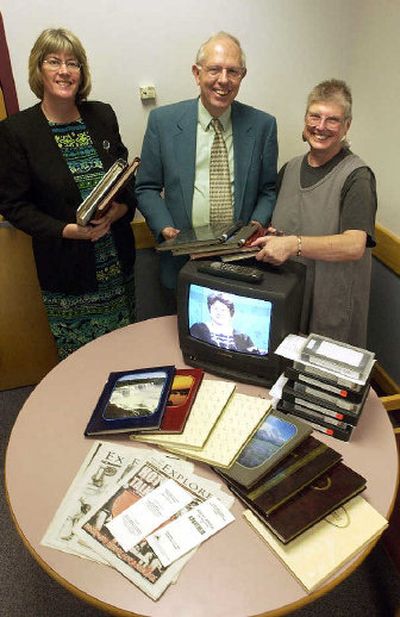Human rights history

The ballpoint pens and lists of scribbled names that Tony Stewart collected over 35 years may seem like worthless mementos to some. But those items are part of a priceless collection that could serve as the foundation for human rights task forces everywhere.
“I have an incredible amount of materials, and I’m the only one who has them,” Stewart says. “Recording history is so important. So many things happen that are of significance that are totally lost.”
Stewart vowed as a new North Idaho College political science instructor 36 years ago to save anything connected with NIC. Ten years later, Stewart helped form the Kootenai County Task Force on Human Relations and pledged to save everything connected with it.
Now, he has 16 boxes filled with memorabilia from the task force. Those boxes hold everything from the pen former Idaho Gov. Cecil Andrus used to sign human rights legislation to videotapes of the destruction of the watchtower at the Aryan Nations compound north of Hayden Lake. To celebrate its 25th anniversary this year, Stewart decided to donate his collection to NIC’s library.
“It’s an invaluable resource to anyone doing research on the history of human rights movements,” says Denise Clark, one of the NIC librarians working with the special collection. “It’s a great tool for historians but also for any small community that wants to see how a successful task force operates.”
Stewart also plans to use the collection in a nine- or 10-part public affairs series that will air on public television stations in seven states and two Canadian provinces January through March. The documentary-style series will chronicle the history of the task force, from events that led to its birth through the transformation of the Aryan Nations compound into the Peace Park.
The first show will explain the history of civil rights in the United States, from slavery to segregation to the successful demands for equal rights that displaced white supremacists from their longtime homes. In 1973 when former Aryan Nations leader Richard Butler chose to settle in North Idaho, the Pacific Northwest showed the most potential as a white enclave, Stewart says.
The white supremacists’ first activities in 1980 led to the formation of the Kootenai County Task Force on Human Relations. That’s where the first program will end.
The next four shows were taped in the 1980s as history was made with bombings in Coeur d’Alene, the birth of deadly Aryan Nations spin-offs like the Order and community human rights rallies that attracted media from around the world.
The final four or five shows are where Stewart will incorporate his collection the most. Those shows will cover the years since 1992. Stewart has video recordings of every press conference the task force scheduled. Press conferences always were arranged around such turning points as the roadside attack on the Keenan family that led to the Aryan Nations demise in North Idaho.
Stewart plans to interview key players in the task force and back up their stories with video clips and other memorabilia from his collection in traditional documentary style. His videos will include a Hands Across the Border ceremony in 1998 demonstrating the Inland Northwest’s commitment to human rights, and civil rights attorney Morris Dees speaking at the task force’s annual human rights banquet following the trial that expelled the Aryan Nations from North Idaho.
They’ll also include the last appearance of Bill Wassmuth. Wassmuth was the St. Pius Catholic church priest whose house was bombed by the Aryan Nations in the 1980s. He was the leader of the Northwest Coalition Against Malicious Harassment until he was diagnosed with Lou Gehrig’s disease. Wassmuth died in 2002.
For the last show, Stewart plans to discuss with three people who followed the task force for 25 years how its activities changed the Inland Northwest. Those people may include a reporter and politician, he says.
“I want to celebrate 25 years and show the history,” he says. “Many civil rights groups are 100 years old, but we may be the oldest human rights task force in the country.”
Over the years, towns across the nation have invited Stewart and other task force leaders to share their experiences and help them launch similar efforts. Stewart’s collection and the public affairs series NIC is producing will expand the task force’s reach, says Clark.
“We hope to digitize some of these materials and have some of the most interesting on a Web site on the Internet so they’re available to the public,” she says.
Most higher learning institutions in the region share information on an Internet pipeline. Clark says NIC will add Stewart’s collection to that pipeline for classroom use and research.
The NIC Public Forum television series of the task force’s 25 years will start in January and run for two months over Idaho Public Television, channel 12, on Saturdays and Spokane Public Television, KSPS channel 7, on Sundays.
“You have to capture these things before it’s too late,” Stewart says. “From the task force’s perspective, it’s our gift to the population.”